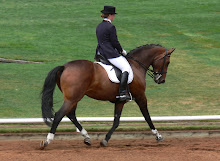All week has been unbelievably cold around here, Tuesday through Thursday highs were around 16, lows subzero. Ick! I never thought 20 degrees would actually feel warm.
I read a very thought-provoking post on the 'net a few days ago, and decided to re-post my response here. The original post, by a veterinarian/dressage rider, brought up some interesting points about how riders' horses reflect their own balance issues and speculated how these rider induced problems can lead to long-term soundness problems in the horse. The original post specifically "picked on" dressage riders as being more guilty of creating a host of soundness and physical problems in their horses, as opposed to other disciplines (specifically eventing).
Here is my response:
When I was 15 or so, my half-Arab came up a little lame behind (right hind). We did diagnostic work (x-rays) and found mild arthritis. We also had a massage therapist/chiropractor come out and work on him. This guy was amazing, he worked on the horse for a bit, then proceeded to tell me exactly how I was sitting, which leg would be forward, how my hips were twisted, etc. And he was exactly right. He understood rider biomechanics better than most instructors.
This brought up a huge moral dilemma, which your post so beautifully describes...how can dressage, which is supposed to make the horse's more balanced, stronger, more even, actually create lameness or possibly lead to breakdown? How can one do dressage knowing this?
My resolution is to acknowledge this danger, and to pay attention to dressage specifically as a therapeutic means. Good riding should make the horses go better, more balanced, more sound. That means structuring your program accordingly and looking to yourself for chronic imbalances. But this is difficult...to become this rider requires more time and energy than most people can commit (most only ride one horse a day, if that). Many people also want to look outside themselves for lameness issues, they don't deal with it as a training issue (and by training, I mean a fundamental balance problem with horse/rider). You can pour as much money as you like into your chiropractor or massage therapist or whomever, but if your way of riding is creating the problem, it will ultimately get you nowhere.
To this day I still have problems getting my horses to use their right hind leg property, which tends to overload the left shoulder. I still sit slightly crooked (too heavy on the left). Guess what, even good riders aren't perfect, and even slight imperfections will show up in the horse's way of going. Similarly, I can sit on any horse and feel some degree of unevenness/unlevelness. They aren't perfectly ambidextrous either. The job of training is to improve on this.
I agree 100% that many dressage horses are overweight and underworked. I tend to like mine on the lighter side (by dressage horse standards). I have had this discussion with several clients (your horse is obese), I have absolutely NO idea how anyone can expect an athlete to be overweight and perform to their optimum. Unfortunately most clients don't listen until they have a horse founder. It takes a vet to convince them.
I have also started incorporating more outdoor riding in my program (we have several outdoor arenas and a cross country course here, plus it doesn't rain as much here). Also some light jumping/cavaletti work. I think these are good ways to build strength and work different muscle groups. I also think the horses balance themselves better outdoors (not as many tight turns as in an indoor). Also my dressage program is very structured in the sense that I don't go out and work the same way every day. I have hard days (more collection, perhaps), then more forward/longer riding, some days only walking with lateral work (or a hack), etc. Sometimes the lateral work emphasizes engagement, sometimes looseness. It depends on what I think the horse needs. But even in a "light" ride the horse is still balanced. My version of a "light" ride is still harder than what most people think.
Furthermore, I think some people confuse what is comfortable for them, with what is best for their horse. Sure, Dobbin is probably "happier" cruising around on the forehand forever and argues whenever he is asked to use his hindend, but ultimately it will break down his front legs if continued forever. So the rider will have to go out of their comfort zone. That doesn't mean drill engagement every day of the week!
I think the moral dilemma I described earlier is brought into full relief in the rollkur discussion. Especially since you have the upper echelon riders doing, what looks to many people, as something abusive or physically destructive to their horses. How can this be compatible with the basic principles of dressage? But you're right, the rollkur discussion is really a small portion of the larger moral problem that faces every dressage rider.
Hope you find this issue as thought-provoking as I do!
Saturday, December 12, 2009
Subscribe to:
Post Comments (Atom)

No comments:
Post a Comment